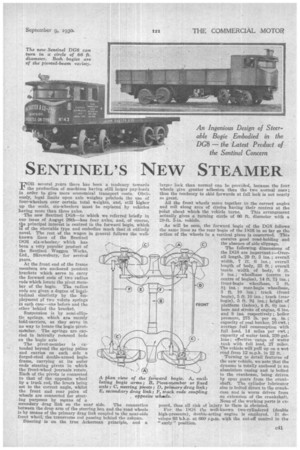SENTINEL'S NEW STEAMER
Page 63

If you've noticed an error in this article please click here to report it so we can fix it.
FOR several years there has been a tendency towards the production of machines having still larger pay-loads in order to give more economical transport costs. Obvi-. ously, legal limits upon axle weights preclude the use of four-wheblez's over certain total Weights, and, still higher up the scale, six-wheelers must be replaced by vehicles having more than three axles.
The new Sentinel DG8—to which we referred briefly in our issue of August 26th—has four axles, and, of course, the principal interest is centred in the forward bogie, which is of the steerable type and embodies much that A entirely novel. The rest of the wagon in general follows the wellknown lines of the Sentinel DG6 six-wheeler, which has been a very popular product of the Sentinel Waggon Works, Ltd., Shrewsbury, for several years.
At the front end of the frame members are anchored pendent brackets which serve to carry the forward ends of two radius rods which locate the pivot member of the bogie. The radius rods are given a degree of lovitudinal elasticity by the employment of two volute springs in each case—one before and the other ' behind the bracket.
Suspension is by semi-elliptic springs, which ara merely lotid-carriers, as they serve in no way to locate tho bogie pivotmetnber. The springs are carried in laterally recessed beds on the bogie axle The pivot-member is extended beyond the spring palms and carries on each side a forged-steel double-armed bogie frame, carrying at its outer ends steering pivots in which the front-wheel journals rotate. Each of the pivots is connected to that of the opposite wheel by a track rod, the levers being set to the correct angle, whilst the front and rear pairs of wheels are connected for steering purposes by means of a secondary drag link on the near side. The connection between the drop arm of the steering box and the road wheels is by means of the primary drag link coupled to the near-side front wheel, the transverse rod passing behind the ashpan. Steering is on the true Ackerman principle, and a larger lock than normal eau be provided, because the four wheels give greater adhesion than the two normal ones; thus the tendency to skid forwards at full lock is not nearly so great.
All the front wheels move together to the correct angles and roll along arcs of circles having their centres at the point about which the vehicle turns. This arrangement actually gives a turning circle of 66 ft. diameter with a 29-ft. 5-in. vehicle.
As will be seen, the forward bogie of the DG8 follows the same lines as the rear bogie of the DG6 in so far as the action of the wheels in a vertical plane is concerned. This ensures good road-holding and the absence af side slippage.
The following dimensions of the DG8 are important :—Overall length, 29 ft. 5 ins.; overall width, 7 ft. 6 ins.; overall length of body, 23 ft. ; overall inside width of body, 6 ft.
ins.; wheelbase (centre to centre of bogies), 14 ft. 71 ins.; front-bogie wheelbase, 3 ft. 81 ins.; rear-bogie wheelbase, 3 ft 10 ins. ; track (front bogie), 5 ft. 10 ins.; track (rear bogie), 5 ft. 9* ins.; height of platform (laden), 4 ft. OA ins.; bore and stroke of engine, 6 ins. and 8 ins. respectively ; boiler pressure, 275 lb. per sq. in.; capacity of coal bunker, 10 cwt.; average fuel consumption with full load, 14 miles per cwt.; capacity of water tank, 230 gallons; effective range of water tank with full load, 27 miles. The vehicle will pull up on a wet road from 12 m.p.h. in 22 ft.
Turning to detail features of the new vehicle, we note that the dynamo is totally enclosed in au aluminium casing and is bolted to the crankcase, being driven by spur gears from the crankshaft. The cylinder lubricator also is bolted direct to the crankcase and is worm driven from an extension of the crankshaft. None of the working parts is exposed, thus all risk of injury to them is obviated.
For the DOS the well-known two-cylindered (double high-pressure), double-acting engine is employed. It develops 93 b.h.p. at 660 r.p.m. with the cut-off control in the " early" position.












































































































